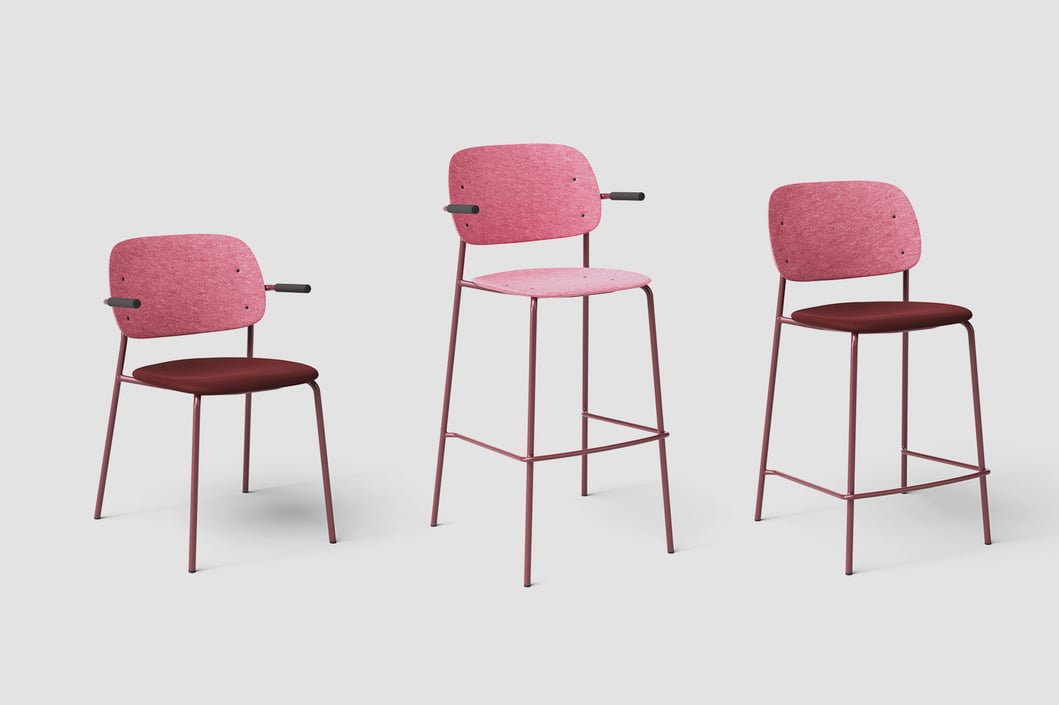Journal
The Making of Hale Series | A Conversation With the Designers
The design of the Hale family was inspired by the school chair. But there is more to it. In this interview, the design team told us how they managed to combine a no-nonsense, almost classic design with the innovative production technique.

We sat down with designer Ivan Kasner (Studio Ivan Kasner) and product developer Jochem Kruizinga (De Vorm), who designed the Hale series. Hale might seem like a simple design, but looks can be deceiving as we found out with Ivan and Jochem. And the Red Dot Design Award 2020 is another confirmation of that!
The design principle of a lean frame with a loose seat and back have often been designed through time. What is there to add?
Jochem: We already have a successful chair family, the LJ series. But we felt that we could do more with the PET Felt material and cut down on production steps. So we started looking at the production process with our supplier and look for ways of improvement. Also, we wanted to add stackability.
 Ivan: As Jochem said, De Vorm didn’t want to make another school chair, we wanted to produce more efficiently and get a chair that is stackable. The current design was the most suitable for this purpose. And it is true, there are a lot of similar-looking chairs out there. But because of the possibilities of the PET Felt material, we felt like we could really add something. This is a very comfortable chair, fully customisable and still very affordable. Comfort is especially important to us. A chair shouldn’t only look good, but in the first place provide proper body support."
Ivan: As Jochem said, De Vorm didn’t want to make another school chair, we wanted to produce more efficiently and get a chair that is stackable. The current design was the most suitable for this purpose. And it is true, there are a lot of similar-looking chairs out there. But because of the possibilities of the PET Felt material, we felt like we could really add something. This is a very comfortable chair, fully customisable and still very affordable. Comfort is especially important to us. A chair shouldn’t only look good, but in the first place provide proper body support."
''Because of the possibilities of the PET Felt material, we felt like we could really add something.''
That speaks for itself, doesn’t it?
Ivan: Well, apparently it doesn’t! Often when price reduction comes along, comfort is cut back too. When you are working with plywood, for instance, the seat and back basically have the same front and back shape. It’s hard to get a double curvature and the shape needed for your body automatically offsets the shape you need to work with for the frame. With this new production process in PET Felt, we were able to make a double curvature spine that is comfortable and ergonomic and had the freedom to design a rich look and feel complementing the stackable frame.
 You both mentioned the production process, what is so special about the Hale series and how it is made?
You both mentioned the production process, what is so special about the Hale series and how it is made?
Jochem: Because we produce locally in Western Europe, we were able to quickly improve and innovate on the design. At De Vorm, we don’t start with the design and then figure out how to make it. We start from the production process and make a design based on what is possible or what we think should be possible. It takes three steps to produce a shell of the LJ series. For the Hale chair, we cut that process down to one step. Not only is that more efficient, but also more sustainable, since the new technique allows to reduce the leftover material. We invented this whole process, and it is really cool to see the end result in the Hale series.
''At De Vorm, we don’t start with the design and then figure out how to make it. We start from the production process and make a design based on what is possible or what we think should be possible.''
Ivan: Hale series is also the first PET Felt product with a double 3D shape. You see that the thickness of the PET Felt is different everywhere. The Hale has thicker edges and recesses for the frame. These edges give a good grip for lifting and stacking the chairs. We really pushed the process and material to a new level. Now we have an ultimate balance between a slender look and a sturdy chair.

What makes this chair sustainable?
Jochem: There are a couple of reasons why this is a sustainable chair. The PET Felt is made from recycled plastic bottles and the frame is made from high tension, durable steel. But materials is only one of the factors. The Hale series is also stackable, making transport very efficient. All the products of the Hale series are easy to disassemble and recycle after a long lifespan. At the end, it is just steel and PET. We also produce locally in Western Europe to keep transportation at a minimum.
Thanks for this interview and congratulations on winning the Red Dot Design award!
Jochem and Ivan: Thanks!


